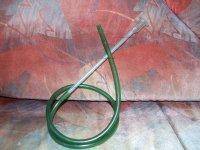The principle and usage of an aquarium cleaner
Quick navigation – Answers
Introduction
Aquarium vacuum cleaner is a simple and cheap tool that costs around $US 3, it is designed to pump the water out/into the tank while the water is moved from one container to another container (in general, the container is a bucket). A water change should take place as new water has to be introduced into a tank on a regular basis. Bear in mind you shouldn’t use any water taken from the duct without leaving it 1-2 days in some bucket, otherwise you're posing your tank to a risk of introducing chlorine there.
Water changes
In general it is recommended to perform an approximately 10% to 20% water change on a regular basis, ideally every week. However depending on the volume of water held in your aquarium this number can be reduced to just 5% for large tanks (over 300 litres) up to 40% which is valid for tanks that contain less than 20 litres of water. Aquarists have to perform regular water changes in order to remove poisonous substances that are present in excrements of fish, and in order to simulate rainy seasons which in the end trigger breeding in many fish species.
A water change isn't necessary only when there's some excrement found on the substrate, but it should become a regular task that one gets used to as time goes by. Daily changes have to be avoided as this activity causes stress in fish which may later result in diseases and unwillingness to breed.
Certain setups don't even need a water change as they are almost autonomous ecosystems that lives its own life. The aspects on which the previous statement relies is the number of fish, plants, substrate’s capability to decompose the waste, aeration, presence of driftwood (this releases tannin required by many species to kickstart the breeding process), etc. For some setups pieces of driftwood are a great addition as they will colour the water to brown or yellow, i.e. when we speak about South American creeks and others. Please, bear in mind that brown or yellow water colour is not dangerous for any fish specimen! Fish are beings which live in the tank, thus don’t try to simulate “clean and perfect human house” there!
In addition, changing 20% of water will not result in crystal-clear and transparent water. It will work for about 2-3 days and then colours usually return to their previous state.
Now it comes to the point of this article, the vacuum cleaner which is ideal for performing water changes.
Video
Feel free to download our video which shows how to pump the water with an aquarium cleaner right here. It's a mpg file, type MPEG-1, 640x480, approximately 22.5 MB.
The principle
A fish tank cleaner works on the principle that two water entities at two different altitudes interconnected by a tube achieve their equilibrium point after both water levels reached the same altitude or if the water mass in both tanks was moved to the lowest available point without being connected together through the tube. If the water has to move into lower point, it might pass through higher point than it is actually at.
This is the reason why an aquarium has to be placed at a higher position than a “destination” container (a tank - bucket - for used water). Of course, if you are about to put new water to the fish tank, you must place it somewhere above your aquarium. The head should be 50 cm at least.
The device
An aquarium cleaner is a long, flexible plastic tube which has a hard and enlarged tube at its end. Moreover, there are several variants available on the market:
A manual pump. A plastic bubble which contains air and if you press the bubble it starts to pump. If the enlarged end of the cleaner is present in the water then it will pump the water out from the aquarium.
Another solutions are are cleaners powered by „mouth“. You put the flexible end into your mouth and then you “suck” (not really, but it happens sometimes) the water until it starts to flow from the source tank to the destination point automatically. This happens once there is enough under pressure in the tube.
Warning
You have to be careful if you use a cleaner, because it may suck small fish as well. Some cleaners have nets on the enlarged part, but the pressure might harm the fish anyway. Stress is a limiting factor when using this device since small specimens may encounter serious issues once they are, or nearly are, sucked out from their aquarium. They can easily die because of such stress.
You should pay great attention when cleaning the substrate. If there is enough under pressure, small gravel will move from your aquarium into the bucket. This happens especially when the substrate consists of sand or little rocks. If you don't want this situation to happen you have to choke the flexible end of the cleaner, so that the pressure at the other end will be smaller and it will not suck the substrate.
Naturally, the aquarium cleaner should be cleaned when the work is finished.
Picture
Feel free to visit The Gravel Vacuum at firsttankguide.net too!

